Lesson learned from the public management of Japan’s super-aged society: Looking through 3 paradigms in public administration
Main Article Content
Abstract
Article Details
ข้อความและข้อคิดเห็นต่างๆ ในบทความเป็นของผู้เขียนบทความนั้นๆ ไม่ใช่ความเห็นของกองบรรณาธิการหรือของวารสาร jsn Journal
References
กระทรวงการพัฒนาสังคมและความมั่นคงของมนุษย์ (2557). ประชากรสูงอายุไทย: ปัจจุบันและอนาคต. เอกสารประมวลสถิติด้านสังคม 1/2558 (พฤศจิกายน). กรุงเทพฯ: ศูนย์เทคโนโลยีสารสนเทศและการสื่อสาร สำนักงานปลัดกระทรวงการพัฒนาสังคมและความมั่นคงของมนุษย์.
ปกรณ์ ศิริประกอบ (2558). 3 พาราไดม์ทางรัฐประศาสนศาสตร์: แนวคิด ทฤษฎีและการนำไปปฏิบัติจริง. กรุงเทพฯ: โรงพิมพ์แห่งจุฬาลงกรณ์มหาวิทยาลัย.
สุวรรณี คำมั่น และสุจิตราภรณ์ นาคะลักษณ์ (2547). โอกาสสุดท้ายของประเทศไทย: 6 ปีทองของการสร้างรากฐานการพัฒนาคนให้ก้าวไกลอย่างยั่งยืน. การสัมมนาวิชาการประจำปี 2547 ของมูลนิธิสถาบันวิจัยเพื่อการพัฒนาประเทศไทย เรื่อง “เหลียวหลังแลหน้า: ยี่สิบปีเศรษฐกิจสังคมไทย” วันที่ 27-28 พฤศจิกายน พ.ศ. 2547.
สุวัฒนา เลิศมโนรัตน์ (2546). ระบบประกันสังคมของญี่ปุ่น: กรณีศึกษาการดูแลระยะยาว. (วิทยานิพนธ์ปริญญามหาบัณฑิต มหาวิทยาลัยธรรมศาสตร์).
Berg, B. L. (2007). Qualitative research methods for the social sciences. (6th ed.). Boston, MA: Pearson.
Campbell, J. C. & Ikegami, N. (2000). Long-term care insurance comes to Japan. Health affairs. 19, 3. pp. 26-39.
Denhardt, R. B. & Denhardt, J. V. (2000). The new public service: Serving rather than steering. Public administration review. 60, 6 November/December, pp. 549-559.
Hatano, Y., Matsumoto, M., Okita, M., Inoue, K., Takeuchi, K., Tsutsui, T., Nishimura, & Hayashi, T. (2017). The vanguard of community-based integrated care in Japan: The effect of a rural town on national policy. International journal of integrated care. pp. 1-9.
Hayashi, M. (2015). Japan’s long-term care policy for older people: The emergence of innovative “mobilisation” initiatives following the 2005 reforms. Journal of aging studies. pp. 11-21.
Ikegami, N. (2008). Providing care for the ageing society. In F. Coulmas, H. Conrad, A. Schad-Seifert, & G. Vogt. (Eds.) The demographic challenge: A handbook about Japan. (pp. 1049-1064). Leiden, The Netherland: Brill
Ikegami, N., Byung-Kwan, Y., Hashimoto, H., Matsumoto, M., Ogata, H., Babazono, A., Watanabe, R., Shibuya, K., Bong-Min, Y., Reich, M. R. & Kobayashi, Y. (2011). Japanese universal health coverage: Evolution, achievements, and challenges. The lancet. 378 (9796). pp.1106-1115.
Ikegami, N., Ishibashi, T., & Amano, T. (2014). Japan’s long-term care regulations focus on structure – rationale and future prospects. In V. Mor, T. Lenone, & A. Maresso (Eds.). Regulating long-term care quality: An international comparison. (pp. 121-143). New York: Cambridge University Press.
Iwana, R. (2017). Super aged society: Japan. เอกสารประกอบการบรรยาย Tokyo, Japan: Mitsubishi-UFJ Research and Consulting.
Matsuda, S. & Yamamoto, M. (2001). Long-term care insurance and integrated care for the aged in Japan. International journal of integrated care. 1, 1 (September), pp. 1-11.
Ministry of Health, Labour and Welfare (2017). Japan 2035: Leading the world through health. Brief summary. ที่มา: http://www.mhlw.go.jp/seisakunitsuite/bunya/hokabunya/shakaihoshou/hokeniryou2035/assets/file/healthcare2035_proposal_150703_slide_en.pdf สืบค้นเมื่อ 25 กันยายน ค.ศ. 2017.
Ministry of Health, Labour and Welfare (2016). Long term care insurance system of Japan. ที่มา: http://www.mhlw.go.jp/english/policy/care-welfare/care-welfare-elderly/dl/ltcisj_e.pdf สืบค้นเมื่อวันที่ 23 กันยายน ค.ศ. 2017.
Miskolczi, M. & Csefalvaiova, K. (2013). Process of population ageing and its dynamic. Paper presented at the 7th International days of statistics and economics. Prage, Czech Republic. ระหว่างวันที่ 19-21 กันยายน ค.ศ. 2013.
Olivares-Tirado, P. & Tamiya, N. (2014). Trends and factors in Japan’s Long-Term care insurance system: Japan’s 10-year experience. New York: Springer.
O’leary, Z. (2017). The essential guide to doing your research project. (3rd ed.). Thousand Oaks, CA: Sage publications.
Osborne, D. & Gaebler, T. (1992). Reinventing government: How the entrepreneurial spirit is transforming the public sector. Reading, MA: Addison-Wesley.
Shimizutani, S. (2013). The future of long-term care in Japan. RIETI discussion paper series 13-E-064. Japan: The Research Institute of Economy, Trade and Industry.
Tamiya N., Noguchi, H., Nishi, A., Reich, M. R., Ikegami, N., Hashimoto, H., Shibuya, K., Kawachi, I. & Campbell, J. C. (2011). Population ageing and wellbeing; Lessons from Japan’s long-term care insurance policy. The lancet. 378 (9797). pp 1183-1192.
Tokoro, M. (2009). Ageing in Japan: Family changes and policy developments. In T. Fu & R. Hughes. (Eds.) Ageing in East Asia: Challenges and policies for the twenty first century. (pp. 54-71). New York, NY: Routledge.
Tokyo metropolitan government (2015). Long-term care insurance system. (April) Tokyo, Japan: Bureau of Social Welfare and Public Health.
Tomufumi, S. (2013). Learning from the approaches in Japan. เอกสารนำเสนอที่ The 11th ASEAN & Japan High Level Officials Meeting on Caring Societies. (5 ธันวาคม ค.ศ. 2013).
Weber, M. (1958) by H. H. Gerth & C. W. Mills (translated, edited, and with an introduction). From Max Weber: Essays in sociology. New York: A Galaxy Book.
Yin, R. K. (2003). Case study research: Design and methods. (3rd ed.). Thousand Oaks, CA: Sage Publications


